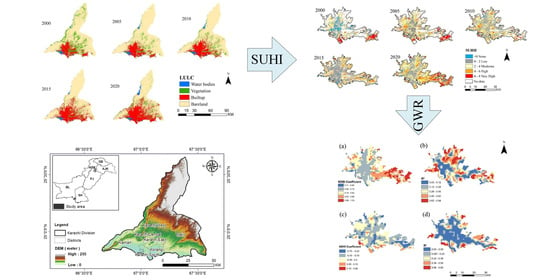Characterizing Spatiotemporal Variations in the Urban Thermal Environment Related to Land Cover Changes in Karachi, Pakistan, from 2000 to 2020
Abstract
1. Introduction
2. Materials and Methods
2.1. Study Area
2.2. Datasets
3. Methods
3.1. Land Use/Land Cover Classification
3.2. Land Surface Temperature Retrieval
3.3. Calculation of the Surface Urban Heat Island Intensity
3.4. Statistical Analysis
4. Results
4.1. Land Use/Land Cover Change Analysis
4.2. Spatiotemporal Variations in the Urban Thermal Environment
4.2.1. Variations in the Normalized Land Surface Temperature
4.2.2. Variations in the Surface Urban Heat Island Intensity
4.3. Relationship between Variations of LST and Land Cover Changes
4.3.1. Relationship between Land Cover Types and Land Surface Temperature
4.3.2. Relationship between Land Cover Composition and Normalized Land Surface Temperature
5. Discussion
6. Conclusions
Author Contributions
Funding
Data Availability Statement
Acknowledgments
Conflicts of Interest
References
- Angel, S.; Parent, J.; Civco, D.L.; Blei, A.; Potere, D. The dimensions of global urban expansion: Estimates and projections for all countries, 2000–2050. Prog. Plan. 2011, 75, 53–107. [Google Scholar] [CrossRef]
- Department of Economic and Social Affairs. World Urbanization Prospects: The 2018 Revision; Department of Economic and Social Affairs, UN: New York, NY, USA, 2019. [Google Scholar]
- Zhou, M.; Lu, L.; Guo, H.; Weng, Q.; Cao, S.; Zhang, S.; Li, Q. Urban Sprawl and Changes in Land-Use Efficiency in the Beijing–Tianjin–Hebei Region, China from 2000 to 2020: A Spatiotemporal Analysis Using Earth Observation Data. Remote Sens. 2021, 13, 2850. [Google Scholar] [CrossRef]
- Oke, T.R.; Stewart, I.D. Local Climate Zones for Urban Temperature Studies. Bull. Am. Meteorol. Soc. 2012, 93, 1879–1900. [Google Scholar] [CrossRef]
- Lu, L.; Weng, Q.; Guo, H.; Feng, S.; Li, Q. Assessment of urban environmental change using multi-source remote sensing time series (2000–2016): A comparative analysis in selected megacities in Eurasia. Sci. Total Environ. 2019, 684, 567–577. [Google Scholar] [CrossRef]
- Sobrino, J.A.; Oltra-Carrió, R.; Sòria, G.; Jiménez-Muñoz, J.C.; Franch, B.; Hidalgo, V.; Mattar, C.; Julien, Y.; Cuenca, J.; Romaguera, M.; et al. Evaluation of the surface urban heat island effect in the city of Madrid by thermal remote sensing. Int. J. Remote Sens. 2013, 34, 3177–3192. [Google Scholar] [CrossRef]
- Grimmond, S. Urbanization and Global Environmental Change: Local Effects of Urban Warming. Geogr. J. 2007, 173, 83–88. Available online: https://www.jstor.org/stable/30113496 (accessed on 15 July 2021). [CrossRef]
- Kikegawa, Y.; Genchi, Y.; Yoshikado, H.; Kondo, H. Development of a numerical simulation system toward comprehensive assessments of urban warming countermeasures including their impacts upon the urban buildings’ energy-demands. Appl. Energy 2003, 76, 449–466. [Google Scholar] [CrossRef]
- Lu, L.; Guo, H.; Corbane, C.; Li, Q. Urban sprawl in provincial capital cities in China: Evidence from multi-temporal urban land products using Landsat data. Sci. Bull. 2019, 64, 955–957. [Google Scholar] [CrossRef]
- Güneralp, B.; Lwasa, S.; Masundire, H.; Parnell, S.; Seto, K.C. Urbanization in Africa: Challenges and opportunities for conservation. Environ. Res. Lett. 2017, 13, 015002. [Google Scholar] [CrossRef]
- Hassan, T.; Zhang, J.; Prodhan, F.A.; Pangali Sharma, T.P.; Bashir, B. Surface Urban Heat Islands Dynamics in Response to LULC and Vegetation across South Asia (2000–2019). Remote Sens. 2021, 13, 3177. [Google Scholar] [CrossRef]
- Kikon, N.; Singh, P.; Singh, S.K.; Vyas, A. Assessment of urban heat islands (UHI) of Noida City, India using multi-temporal satellite data. Sustain. Cities Soc. 2016, 22, 19–28. [Google Scholar] [CrossRef]
- Arshad, S.; Ahmad, S.R.; Abbas, S.; Asharf, A.; Siddiqui, N.A.; Islam, Z.U. Quantifying the contribution of diminishing green spaces and urban sprawl to urban heat island effect in a rapidly urbanizing metropolitan city of Pakistan. Land Use Policy 2022, 113, 105874. [Google Scholar] [CrossRef]
- Waseem, S.; Khayyam, U. Loss of vegetative cover and increased land surface temperature: A case study of Islamabad, Pakistan. J. Clean. Prod. 2019, 234, 972–983. [Google Scholar] [CrossRef]
- Cai, D.; Fraedrich, K.; Guan, Y.; Guo, S.; Zhang, C. Urbanization and the thermal environment of Chinese and US-American cities. Sci. Total Environ. 2017, 589, 200–211. [Google Scholar] [CrossRef]
- Peng, J.; Jia, J.; Liu, Y.; Li, H.; Wu, J. Seasonal contrast of the dominant factors for spatial distribution of land surface temperature in urban areas. Remote Sens. Environ. 2018, 215, 255–267. [Google Scholar] [CrossRef]
- Li, J.; Song, C.; Cao, L.; Zhu, F.; Meng, X.; Wu, J. Impacts of landscape structure on surface urban heat islands: A case study of Shanghai, China. Remote Sens. Environ. 2011, 115, 3249–3263. [Google Scholar] [CrossRef]
- Liu, L.; Zhang, Y. Urban heat island analysis using the Landsat TM data and ASTER data: A case study in Hong Kong. Remote Sens. 2011, 3, 1535–1552. [Google Scholar] [CrossRef]
- Zhou, D.; Bonafoni, S.; Zhang, L.; Wang, R. Remote sensing of the urban heat island effect in a highly populated urban agglomeration area in East China. Sci. Total Environ. 2018, 628, 415–429. [Google Scholar] [CrossRef]
- Choi, Y.-Y.; Suh, M.-S.; Park, K.-H. Assessment of surface urban heat islands over three megacities in East Asia using land surface temperature data retrieved from COMS. Remote Sens. 2014, 6, 5852–5867. [Google Scholar] [CrossRef]
- Maharjan, M.; Aryal, A.; Man Shakya, B.; Talchabhadel, R.; Thapa, B.R.; Kumar, S. Evaluation of Urban Heat Island (UHI) Using Satellite Images in Densely Populated Cities of South Asia. Earth 2021, 2, 86–110. [Google Scholar] [CrossRef]
- Tran, H.; Uchihama, D.; Ochi, S.; Yasuoka, Y. Assessment with satellite data of the urban heat island effects in Asian mega cities. Int. J. Appl. Earth Obs. Geoinf. 2006, 8, 34–48. [Google Scholar] [CrossRef]
- Lee, K.; Kim, Y.; Sung, H.C.; Ryu, J.; Jeon, S.W. Trend analysis of urban heat island intensity according to urban area change in Asian mega cities. Sustainability 2020, 12, 112. [Google Scholar] [CrossRef]
- Petropoulos, G.; Ireland, G.; Griffiths, H.; Islam, T.; Kalivas, D.; Anagnostopoulos, V.; Hodges, C.; Srivastava, P. Spatiotemporal estimates of surface Soil Moisture from space using the Ts/VI feature space. In Satellite Soil Moisture Retrieval; Elsevier: Amsterdam, The Netherlands, 2016; pp. 91–108. [Google Scholar]
- Guha, S.; Govil, H.; Dey, A.; Gill, N. Analytical study of land surface temperature with NDVI and NDBI using Landsat 8 OLI and TIRS data in Florence and Naples city, Italy. Eur. J. Remote Sens. 2018, 51, 667–678. [Google Scholar] [CrossRef]
- Chen, X.-L.; Zhao, H.-M.; Li, P.-X.; Yin, Z.-Y. Remote sensing image-based analysis of the relationship between urban heat island and land use/cover changes. Remote Sens. Environ. 2006, 104, 133–146. [Google Scholar] [CrossRef]
- Zhou, G.; Wang, H.; Chen, W.; Zhang, G.; Luo, Q.; Jia, B. Impacts of Urban land surface temperature on tract landscape pattern, physical and social variables. Int. J. Remote Sens. 2020, 41, 683–703. [Google Scholar] [CrossRef]
- Rizvi, S.H.; Fatima, H.; Iqbal, M.J.; Alam, K. The effect of urbanization on the intensification of SUHIs: Analysis by LULC on Karachi. J. Atmos. Sol.-Terr. Phys. 2020, 207, 105374. [Google Scholar] [CrossRef]
- Ranagalage, M.; Morimoto, T.; Simwanda, M.; Murayama, Y. Spatial analysis of urbanization patterns in four rapidly growing south Asian cities using Sentinel-2 Data. Remote Sens. 2021, 13, 1531. [Google Scholar] [CrossRef]
- Salim, A.; Ahmed, A.; Ashraf, N.; Ashar, M. Deadly Heat Wave in Karachi, July 2015: Negligence or Mismanagement? Int. J. Occup. Environ. Med. 2015, 6, 249. [Google Scholar] [CrossRef][Green Version]
- Rahman, A.; Abdullah, H.M.; Tanzir, M.T.; Hossain, M.J.; Khan, B.M.; Miah, M.G.; Islam, I. Performance of different machine learning algorithms on satellite image classification in rural and urban setup. Remote Sens. Appl. Soc. Environ. 2020, 20, 100410. [Google Scholar] [CrossRef]
- Hassan, Z.; Shabbir, R.; Ahmad, S.S.; Malik, A.H.; Aziz, N.; Butt, A.; Erum, S. Dynamics of land use and land cover change (LULCC) using geospatial techniques: A case study of Islamabad Pakistan. SpringerPlus 2016, 5, 812. [Google Scholar] [CrossRef]
- Ul Din, S.; Mak, H.W.L. Retrieval of Land-Use/Land Cover Change (LUCC) Maps and Urban Expansion Dynamics of Hyderabad, Pakistan via Landsat Datasets and Support Vector Machine Framework. Remote Sens. 2021, 13, 3337. [Google Scholar] [CrossRef]
- Pakistan Bureau of Statistics. Government of Pakistan. 2017. Available online: https://www.pbs.gov.pk/content/final-results-census-2017 (accessed on 31 July 2021).
- Bremner, J.; Frost, A.; Haub, C.; Mather, M.; Ringheim, K.; Zuehlke, E. World population highlights: Key findings from PRB’s 2010 world population data sheet. Popul. Bull. 2010, 65, 1–12. [Google Scholar]
- Baqa, M.F.; Chen, F.; Lu, L.; Qureshi, S.; Tariq, A.; Wang, S.; Jing, L.; Hamza, S.; Li, Q. Monitoring and Modeling the Patterns and Trends of Urban Growth Using Urban Sprawl Matrix and CA-Markov Model: A Case Study of Karachi, Pakistan. Land 2021, 10, 700. [Google Scholar] [CrossRef]
- Neteler, M. Estimating daily land surface temperatures in mountainous environments by reconstructed MODIS LST data. Remote Sens. 2010, 2, 333–351. [Google Scholar] [CrossRef]
- Shaikh, A.A.; Gotoh, K. A satellite remote sensing evaluation of urban land cover changes and its associated impacts on water resources in Karachi, Pakistan. NED Univ. J. Res. 2008, 5, 41–56. [Google Scholar] [CrossRef]
- Tomlinson, C.J.; Chapman, L.; Thornes, J.E.; Baker, C. Remote sensing land surface temperature for meteorology and climatology: A review. Meteorol. Appl. 2011, 18, 296–306. [Google Scholar] [CrossRef]
- Shih, H.-c.; Stow, D.A.; Tsai, Y.H. Guidance on and comparison of machine learning classifiers for Landsat-based land cover and land use mapping. Int. J. Remote Sens. 2019, 40, 1248–1274. [Google Scholar] [CrossRef]
- Lu, L.; Weng, Q.; Xiao, D.; Guo, H.; Li, Q.; Hui, W. Spatiotemporal Variation of Surface Urban Heat Islands in Relation to Land Cover Composition and Configuration: A Multi-Scale Case Study of Xi’an, China. Remote Sens. 2020, 12, 2713. [Google Scholar] [CrossRef]
- Firozjaei, M.K.; Kiavarz, M.; Alavipanah, S.K.; Lakes, T.; Qureshi, S. Monitoring and forecasting heat island intensity through multi-temporal image analysis and cellular automata-Markov chain modelling: A case of Babol city, Iran. Ecol. Indic. 2018, 91, 155–170. [Google Scholar] [CrossRef]
- Bechtel, B.; Demuzere, M.; Mills, G.; Zhan, W.; Sismanidis, P.; Small, C.; Voogt, J. SUHI analysis using Local Climate Zones—A comparison of 50 cities. Urban Clim. 2019, 28, 100451. [Google Scholar] [CrossRef]
- Estoque, R.C.; Murayama, Y. Monitoring surface urban heat island formation in a tropical mountain city using Landsat data (1987–2015). ISPRS J. Photogramm. Remote Sens. 2017, 133, 18–29. [Google Scholar] [CrossRef]
- Deilami, K.; Kamruzzaman, M.; Liu, Y. Urban heat island effect: A systematic review of spatio-temporal factors, data, methods, and mitigation measures. Int. J. Appl. Earth Obs. Geoinf. 2018, 67, 30–42. [Google Scholar] [CrossRef]
- Buyantuyev, A.; Wu, J. Urban heat islands and landscape heterogeneity: Linking spatiotemporal variations in surface temperatures to land-cover and socioeconomic patterns. Landsc. Ecol. 2010, 25, 17–33. [Google Scholar] [CrossRef]
- Siqi, J.; Yuhong, W. Effects of land use and land cover pattern on urban temperature variations: A case study in Hong Kong. Urban Clim. 2020, 34, 100693. [Google Scholar] [CrossRef]
- Chen, T.-L.; Lin, Z.-H. Impact of land use types on the spatial heterogeneity of extreme heat environments in a metropolitan area. Sustain. Cities Soc. 2021, 72, 103005. [Google Scholar] [CrossRef]
- Hamza, S.; Khan, I.; Lu, L.; Liu, H.; Burke, F.; Nawaz-ul-Huda, S.; Baqa, M.F.; Tariq, A. The Relationship between Neighborhood Characteristics and Homicide in Karachi, Pakistan. Sustainability 2021, 13, 5520. [Google Scholar] [CrossRef]
- Yang, W. An Extension of Geographically Weighted Regression with Flexible Bandwidths. Ph.D. Thesis, University of St Andrews, St Andrews, UK, 2014. [Google Scholar]
- Arif, M.; Hussain, I.; Hussain, J.; Sharma, M.K.; Kumar, S.; Bhati, G. GIS-based inverse distance weighting spatial interpolation technique for fluoride distribution in south west part of Nagaur district, Rajasthan. Cogent Environ. Sci. 2015, 1, 1038944. [Google Scholar] [CrossRef]
- Mak, H.W.; Ng, D.C. Spatial and Socio-Classification of Traffic Pollutant Emissions and Associated Mortality Rates in High-Density Hong Kong via Improved Data Analytic Approaches. Int. J. Environ. Res. Public Health 2021, 18, 6532. [Google Scholar] [CrossRef]
- Ke, W.; Cheng, H.P.; Yan, D.; Lin, C. The Application of Cluster Analysis and Inverse Distance-Weighted Interpolation to Appraising the Water Quality of Three Forks Lake. Procedia Environ. Sci. 2011, 10, 2511–2517. [Google Scholar] [CrossRef][Green Version]
- Szymanowski, M.; Kryza, M. Local regression models for spatial interpolation of urban heat island—an example from Wrocław, SW Poland. Theor. Appl. Climatol. 2012, 108, 53–71. [Google Scholar] [CrossRef]
- Hasan, A. Land contestation in Karachi and the impact on housing and urban development. Environ. Urban. 2015, 27, 217–230. [Google Scholar] [CrossRef] [PubMed]
- Building, K.; Regulations, T.P. Chapter 25. Historic Buildings. Sindh Building Control. In Authority (SBCA) Department of Culture and Planning; Government of Pakistan: Islamabad, Pakistan, 2002. [Google Scholar]
- Mehdi, M.R.; Kim, M.; Seong, J.C.; Arsalan, M.H. Spatio-temporal patterns of road traffic noise pollution in Karachi, Pakistan. Environ. Int. 2011, 37, 97–104. [Google Scholar] [CrossRef] [PubMed]
- Qureshi, S. The fast growing megacity Karachi as a frontier of environmental challenges: Urbanization and contemporary urbanism issues. J. Geogr. Reg. Plan. 2010, 3, 306–321. [Google Scholar] [CrossRef]
- Pithawalla, M.B.; Martin-Kaye, P.H.A. Geology and geography of Karachi and its neighbourhood; University Microfilms: Ann Arbor, MI, USA, 1962. [Google Scholar]
- Van Leeuwen, W.J.; Orr, B.J.; Marsh, S.E.; Herrmann, S.M. Multi-sensor NDVI data continuity: Uncertainties and implications for vegetation monitoring applications. Remote Sens. Environ. 2006, 100, 67–81. [Google Scholar] [CrossRef]
- Roy, D.P.; Borak, J.S.; Devadiga, S.; Wolfe, R.E.; Zheng, M.; Descloitres, J. The MODIS Land product quality assessment approach. Remote Sens. Environ. 2002, 83, 62–76. [Google Scholar] [CrossRef]
- Ghimire, P.; Lei, D.; Juan, N. Effect of image fusion on vegetation index quality—a comparative study from Gaofen-1, Gaofen-2, Gaofen-4, Landsat-8 OLI and MODIS Imagery. Remote Sens. 2020, 12, 1550. [Google Scholar] [CrossRef]
- Mumtaz, F.; Tao, Y.; de Leeuw, G.; Zhao, L.; Fan, C.; Elnashar, A.; Bashir, B.; Wang, G.; Li, L.; Naeem, S.; et al. Modeling Spatio-Temporal Land Transformation and Its Associated Impacts on land Surface Temperature (LST). Remote Sens. 2020, 12, 2987. [Google Scholar] [CrossRef]
- Ahmad, W.; Iqbal, J.; Nasir, M.J.; Ahmad, B.; Khan, M.T.; Khan, S.N.; Adnan, S. Impact of land use/land cover changes on water quality and human health in district Peshawar Pakistan. Sci. Rep. 2021, 11, 16526. [Google Scholar] [CrossRef]
- Sadiq Khan, M.; Ullah, S.; Sun, T.; Rehman, A.U.; Chen, L. Land-Use/Land-Cover Changes and Its Contribution to Urban Heat Island: A Case Study of Islamabad, Pakistan. Sustainability 2020, 12, 3861. [Google Scholar] [CrossRef]
- Dilawar, A.; Chen, B.; Trisurat, Y.; Tuankrua, V.; Arshad, A.; Hussain, Y.; Measho, S.; Guo, L.; Kayiranga, A.; Zhang, H.; et al. Spatiotemporal shifts in thermal climate in responses to urban cover changes: A-case analysis of major cities in Punjab, Pakistan. Geomat. Nat. Hazards Risk 2021, 12, 763–793. [Google Scholar] [CrossRef]
- Bowler, D.E.; Buyung-Ali, L.; Knight, T.M.; Pullin, A.S. Urban greening to cool towns and cities: A systematic review of the empirical evidence. Landsc. Urban. Plan. 2010, 97, 147–155. [Google Scholar] [CrossRef]
- Atasoy, M. Assessing the impacts of land-use/land-cover change on the development of urban heat island effects. Environ. Dev. Sustain. 2020, 22, 7547–7557. [Google Scholar] [CrossRef]
- Alibakhshi, Z.; Ahmadi, M.; Farajzadeh Asl, M. Modeling biophysical variables and land surface temperature using the GWR model: Case study—Tehran and its satellite cities. J. Indian Soc. Remote Sens. 2020, 48, 59–70. [Google Scholar] [CrossRef]
- Kashki, A.; Karami, M.; Zandi, R.; Roki, Z. Evaluation of the effect of geographical parameters on the formation of the land surface temperature by applying OLS and GWR, A case study Shiraz City, Iran. Urban Clim. 2021, 37, 100832. [Google Scholar] [CrossRef]
- Khurshid, M.M.; Zakaria, N.; Rashid, A.; Kazmi, R.; Shafique, M. Diffusion of Big Open Data Policy Innovation in Government and Public Bodies in Pakistan. In Proceedings of the First International Conference, INTAP 2018, Bahawalpur, Pakistan, 23–25 October 2018; Revised Selected Papers. Springer: Berlin/Heidelberg, Germany, 2019; pp. 326–337. [Google Scholar] [CrossRef]
- Khurshid, M.M.; Zakaria, N.; Rashid, A.; Ahmad, M.; Arfeen, M.; Faisal, H. Modeling of Open Government Data for Public Sector Organizations Using the Potential Theories and Determinants—A Systematic Review. Informatics 2020, 7, 24. [Google Scholar] [CrossRef]
- Peng, J.; Hu, Y.; Dong, J.; Liu, Q.; Liu, Y. Quantifying spatial morphology and connectivity of urban heat islands in a megacity: A radius approach. Sci. Total Environ. 2020, 714, 136792. [Google Scholar] [CrossRef] [PubMed]
- Koc, C.B.; Osmond, P.; Peters, A. Evaluating the cooling effects of green infrastructure: A systematic review of methods, indicators and data sources. Sol. Energy 2018, 166, 486–508. [Google Scholar] [CrossRef]
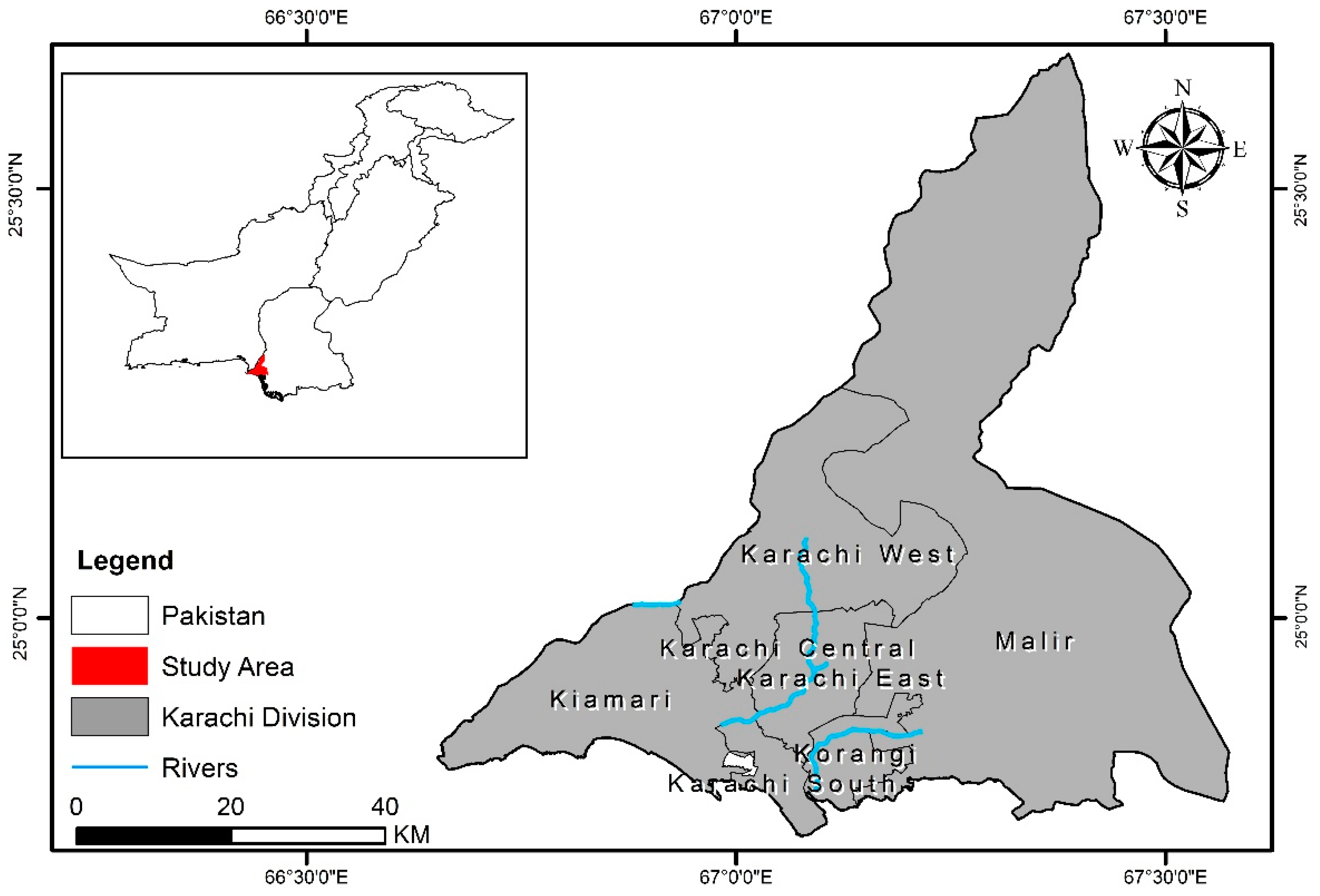
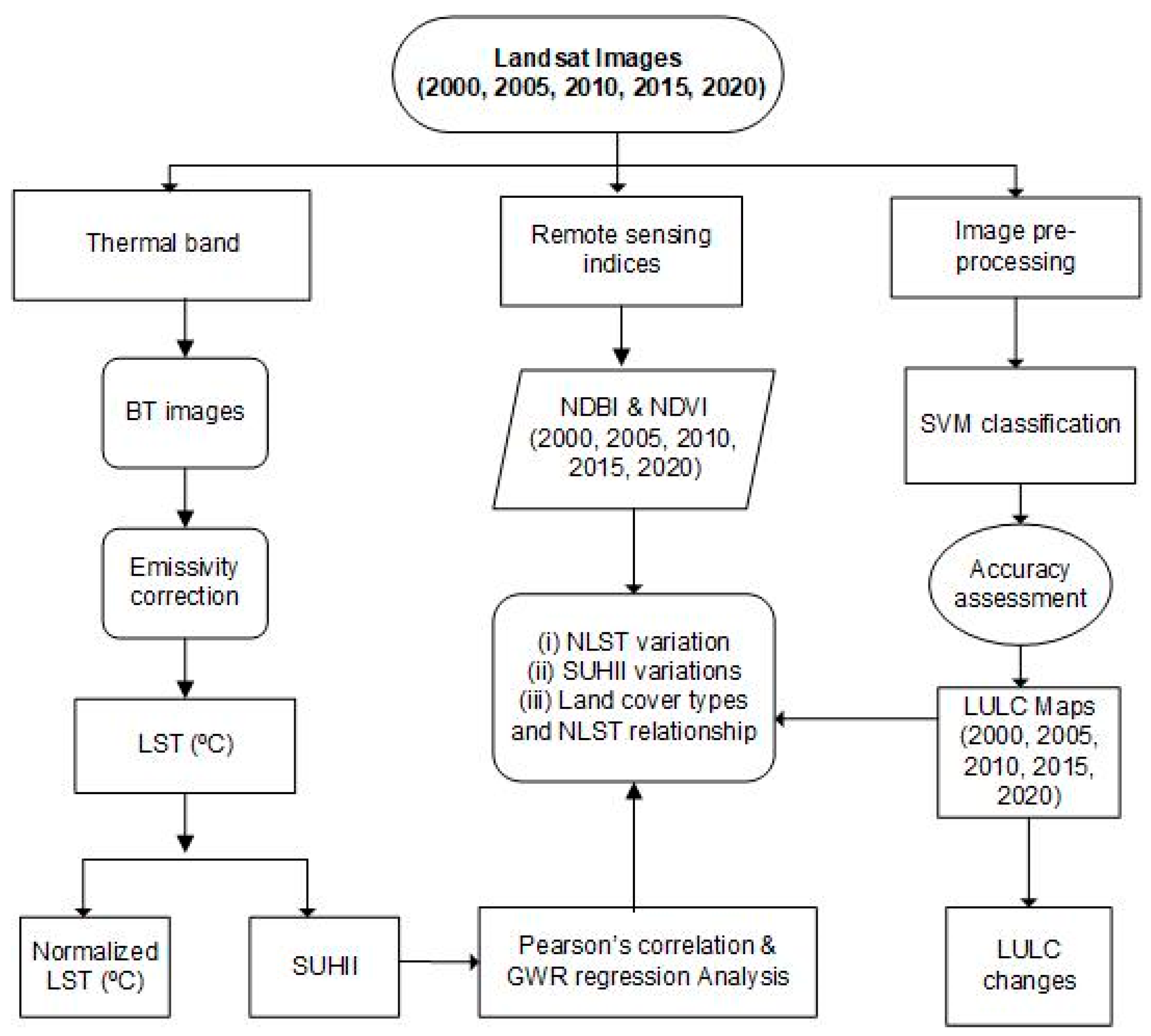
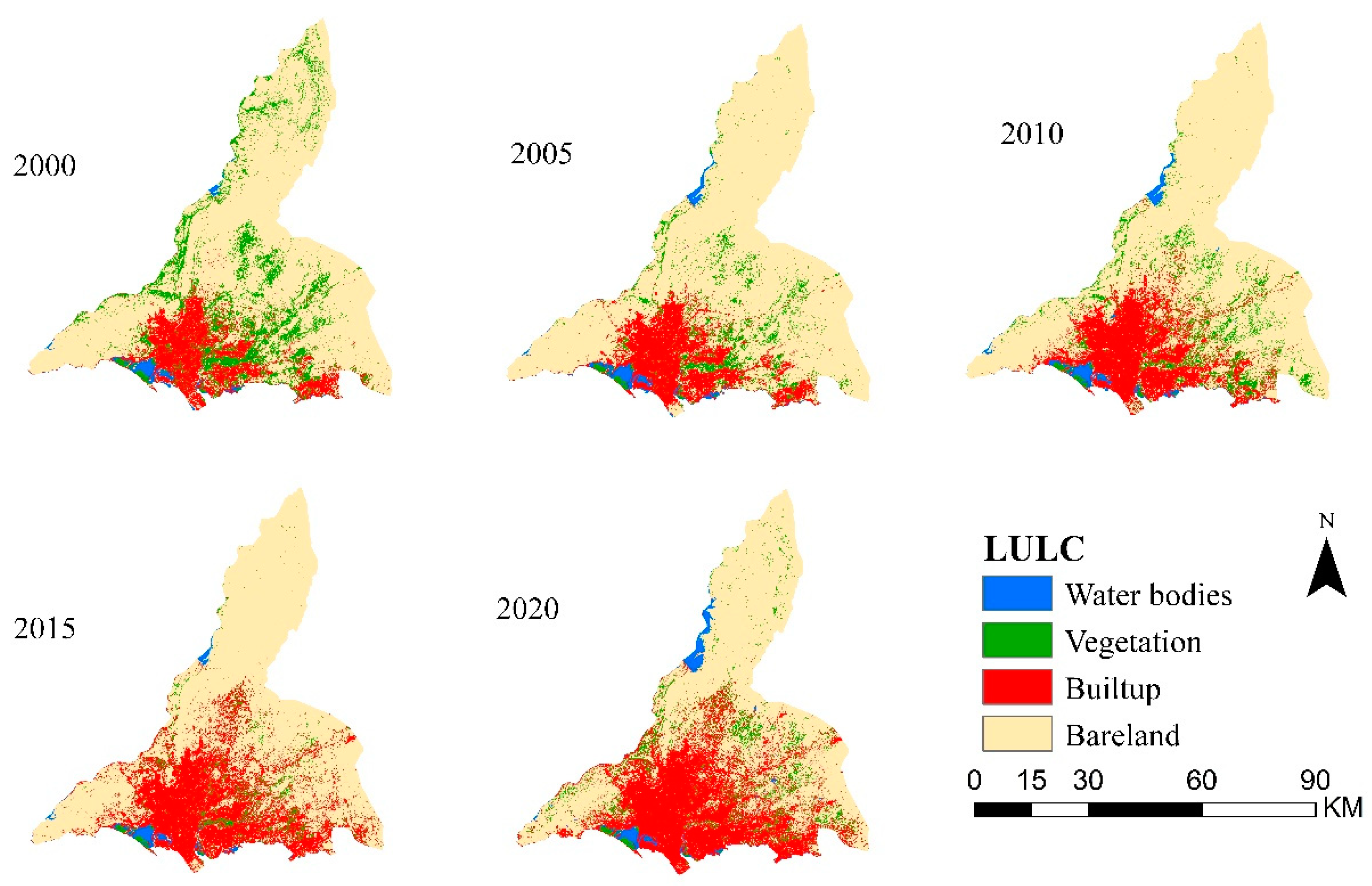

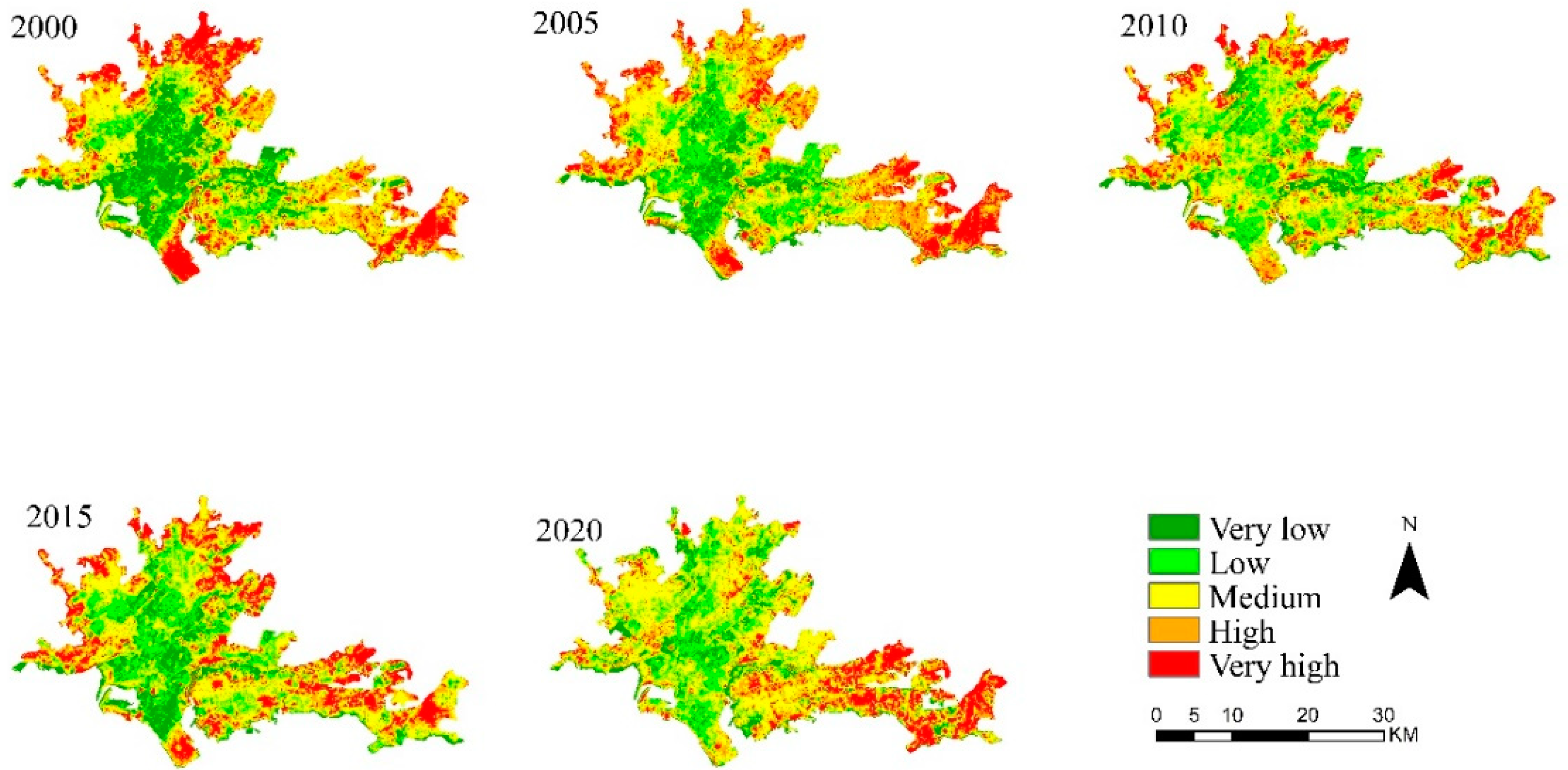
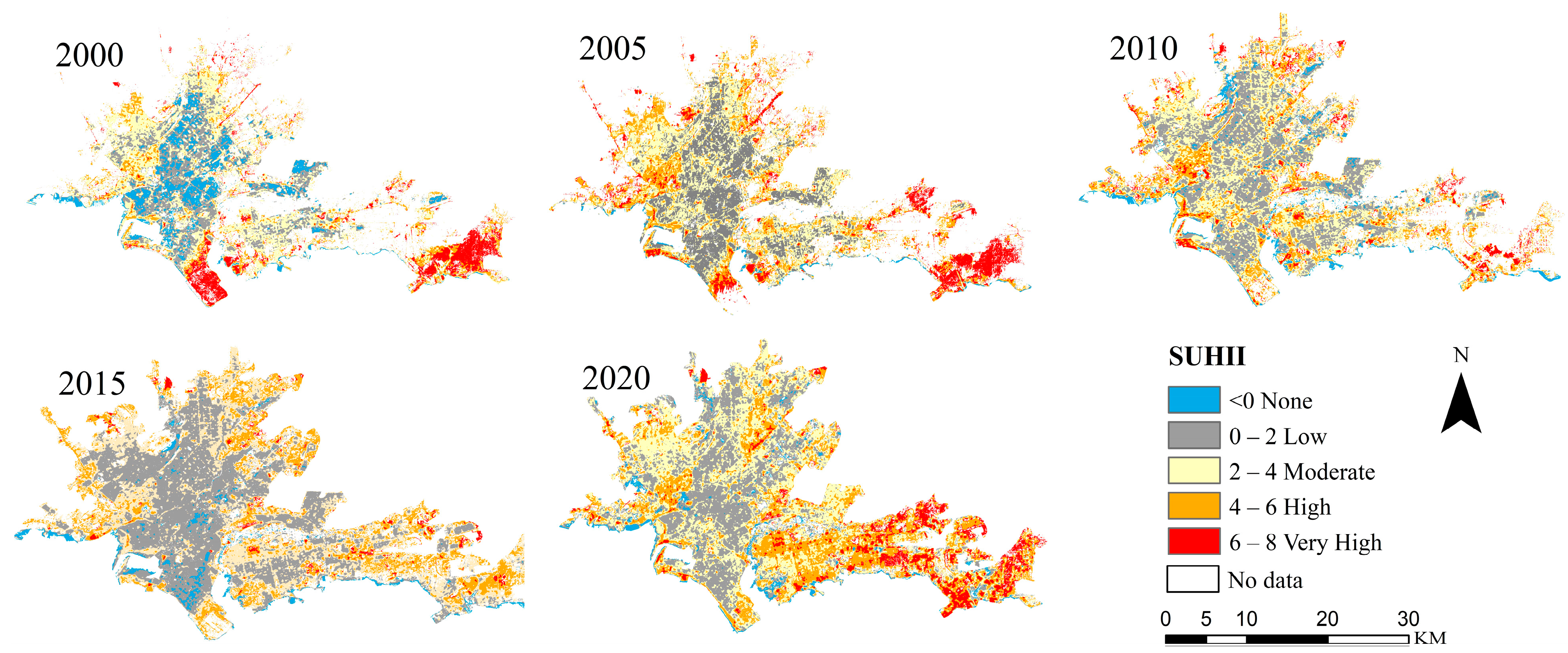

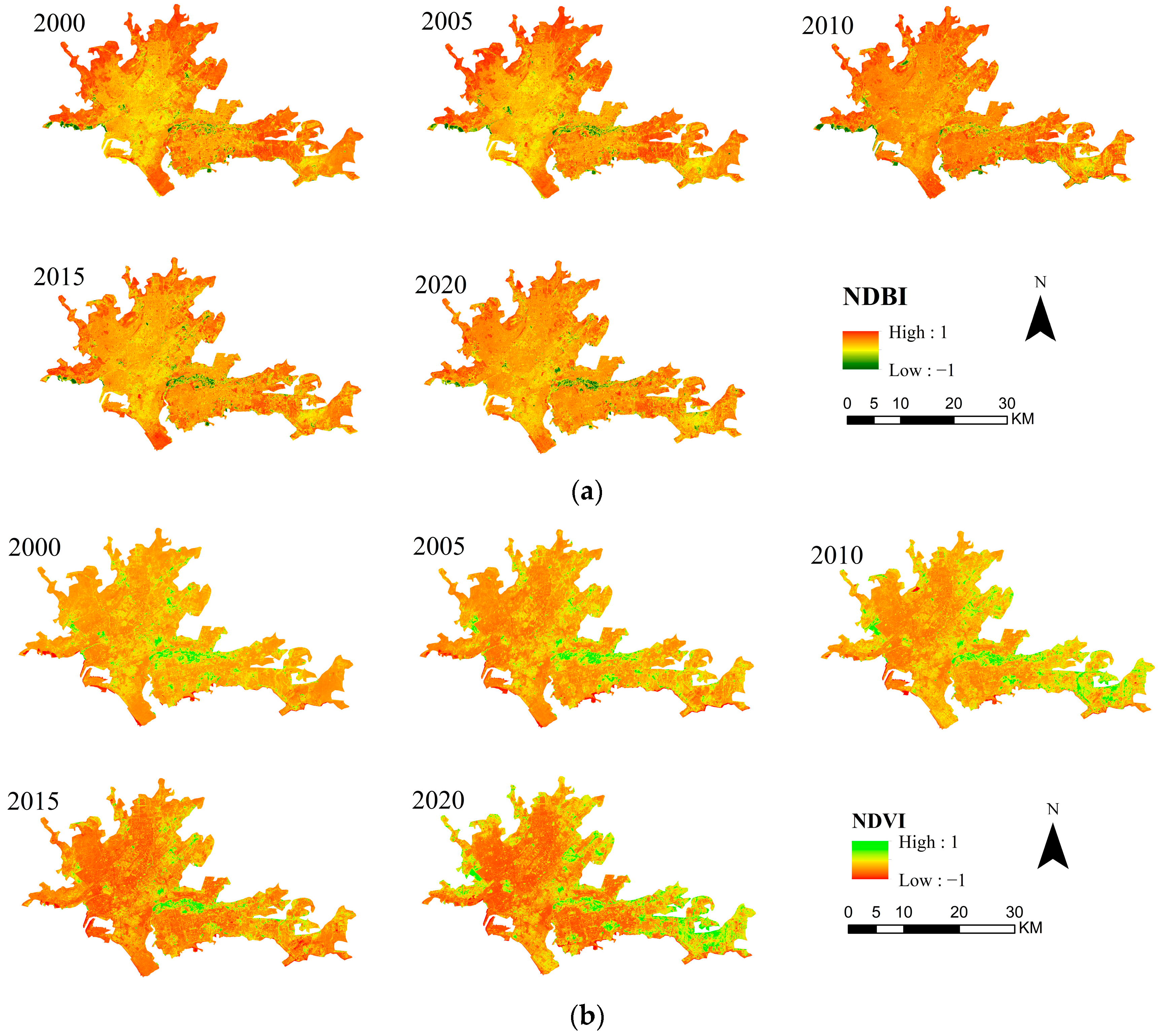
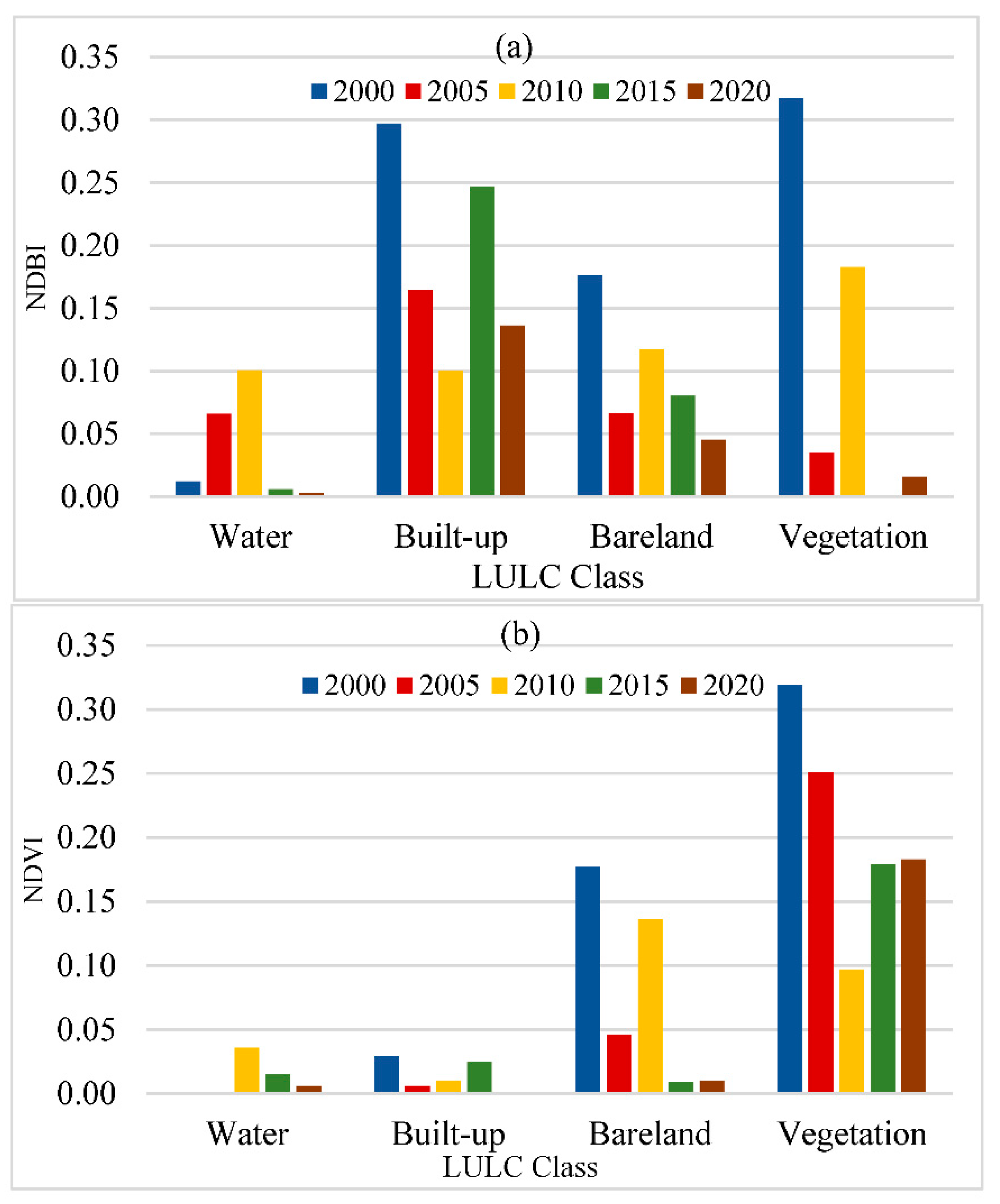
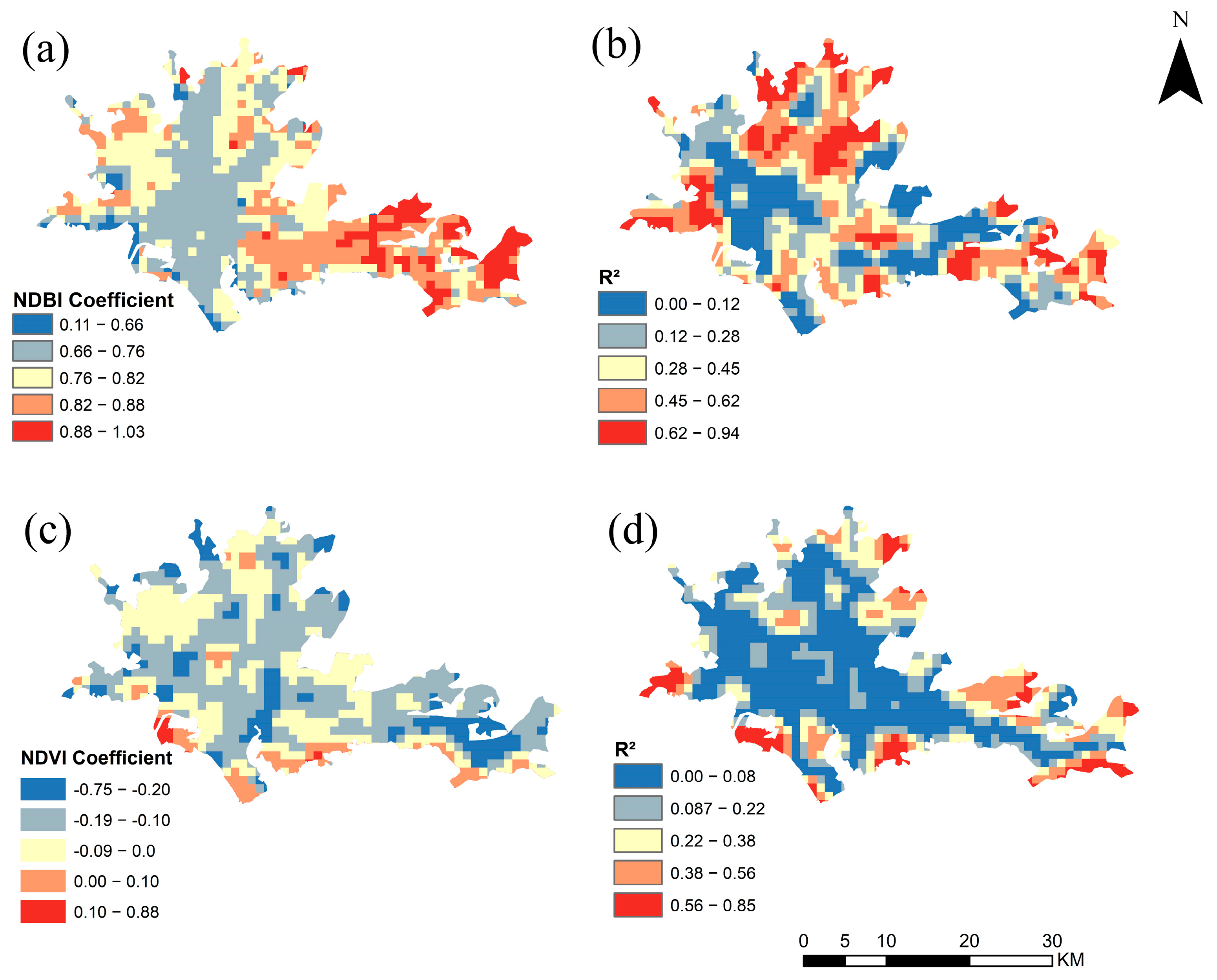
| Year | Date | Satellite and Sensor | Spatial Resolution (m) |
|---|---|---|---|
| 2000 | 26 October 2000 | Landsat5 TM | 30 |
| 1 October 2000 | Landsat5 TM | 30 | |
| 2005 | 16 October 2005 | Landsat7 ETM+ | 30 |
| 7 October 2006 | Landsat5 TM | 30 | |
| 2010 | 7 November 2010 | Landsat5 TM | 30 |
| 21 October 2010 | Landsat7 ETM+ | 30 | |
| 2015 | 5 November 2015 | Landsat8 OLI | 30 |
| 12 November 2015 | Landsat8 OLI | 30 | |
| 2020 | 1 October 2020 | Landsat8 OLI | 30 |
| 24 October 2020 | Landsat8 OLI | 30 |
| LULC Class | Description | No. of Training Pixels | No. of Testing Pixels |
|---|---|---|---|
| Water bodies | Rivers, permanent open water, lakes, ponds, and reservoirs | 60 | 120 |
| Built-up area | Residential areas, land used for commerce and services, industry, transportation, and roads | 150 | 240 |
| Vegetation | Agricultural areas, crops, fallow land and vegetation, and scrub | 150 | 240 |
| Bare land | Exposed soils, landfill sites, areas of active excavation, and open bare land | 150 | 240 |
| Land Cover | 2000 | 2005 | 2010 | 2015 | 2020 | |||||
|---|---|---|---|---|---|---|---|---|---|---|
| Prod. | User | Prod. | User | Prod. | User | Prod. | User | Prod. | User | |
| Type | (%) | (%) | (%) | (%) | (%) | (%) | (%) | (%) | (%) | (%) |
| Built-up | 97.5 | 100 | 75 | 93.75 | 95.12 | 97.29 | 90 | 97.43 | 87.5 | 87.5 |
| Bare land | 95 | 90.47 | 94.5 | 78 | 95.12 | 86.66 | 97.5 | 95.12 | 87.5 | 63.63 |
| Vegetation | 85 | 85 | 92.5 | 94.87 | 100 | 92.85 | 95 | 88.37 | 97.5 | 86.66 |
| Water bodies | 80 | 84.21 | 95 | 100 | 75 | 93.75 | 85 | 100 | 80 | 100 |
| Overall | 90 | 89 | 92.14 | 94.28 | 86 | |||||
| accuracy (%) | ||||||||||
| Kappa coefficient | 0.8 | 0.85 | 0.8 | 0.92 | 0.86 | |||||
| Land Cover Type | 2000 | 2005 | 2010 | 2015 | 2020 | |||||
|---|---|---|---|---|---|---|---|---|---|---|
| Area | Percentage | Area | Percentage | Area | Percentage | Area | Percentage | Area | Percentage | |
| (km²) | (km²) | (km²) | (km²) | (km²) | ||||||
| Built-up | 440.19 | 12.20 | 537.79 | 14.91 | 606.49 | 16.80 | 680.62 | 18.79 | 765.52 | 21.14 |
| Bare land | 2570.19 | 71.24 | 2415.24 | 66.94 | 2512.99 | 69.63 | 2425.58 | 66.98 | 2390.58 | 66.02 |
| Vegetation | 553.99 | 15.35 | 465.01 | 12.89 | 428.07 | 11.86 | 477.13 | 13.18 | 378.13 | 10.44 |
| Water bodies | 43.54 | 1.21 | 58.80 | 1.63 | 61.59 | 1.71 | 38.14 | 1.05 | 86.53 | 2.39 |
| Temperature Class | Very Low Temperature | Low Temperature | Medium Temperature | High Temperature | Very High Temperature |
|---|---|---|---|---|---|
| Range | (T ≤ Tmean − 1STD) | (Tmean − 1STD < T <Tmean − 0.5STD) | (Tmean − 0.5STD < T <Tmean + 0.5STD) | (Tmean + 0.5STD < T <Tmean + 1STD) | (Tmean + 1STD < T) |
| Year | |||||
| 2000 | 15,687.36 | 10,872.99 | 27,408.42 | 3675.51 | 14,628.87 |
| 2005 | 11,025.90 | 14,597.91 | 27,034.11 | 17,903.16 | 10,696.77 |
| 2010 | 8844.30 | 17,358.57 | 31,042.08 | 13,228.56 | 10,783.26 |
| 2015 | 11,649.96 | 18,408.15 | 26,046.63 | 12,450.24 | 12,702.69 |
| 2020 | 9451.89 | 14,931.09 | 33,634.26 | 10,318.41 | 12,922.29 |
| SUHI Zone | 2000 | 2005 | 2010 | 2015 | 2020 |
|---|---|---|---|---|---|
| None/No SUHI | 0.43 | 0.02 | 0.27 | 0.63 | 0.09 |
| Low | 0.67 | 0.76 | 1.31 | 1.3 | 1.13 |
| Moderate | 0.55 | 0.87 | 0.88 | 0.94 | 1.39 |
| High | 0.29 | 0.56 | 0.44 | 0.57 | 0.96 |
| Very High | 0.21 | 0.31 | 0.09 | 0 | 0.33 |
Publisher’s Note: MDPI stays neutral with regard to jurisdictional claims in published maps and institutional affiliations. |
© 2022 by the authors. Licensee MDPI, Basel, Switzerland. This article is an open access article distributed under the terms and conditions of the Creative Commons Attribution (CC BY) license (https://creativecommons.org/licenses/by/4.0/).
Share and Cite
Baqa, M.F.; Lu, L.; Chen, F.; Nawaz-ul-Huda, S.; Pan, L.; Tariq, A.; Qureshi, S.; Li, B.; Li, Q. Characterizing Spatiotemporal Variations in the Urban Thermal Environment Related to Land Cover Changes in Karachi, Pakistan, from 2000 to 2020. Remote Sens. 2022, 14, 2164. https://doi.org/10.3390/rs14092164
Baqa MF, Lu L, Chen F, Nawaz-ul-Huda S, Pan L, Tariq A, Qureshi S, Li B, Li Q. Characterizing Spatiotemporal Variations in the Urban Thermal Environment Related to Land Cover Changes in Karachi, Pakistan, from 2000 to 2020. Remote Sensing. 2022; 14(9):2164. https://doi.org/10.3390/rs14092164
Chicago/Turabian StyleBaqa, Muhammad Fahad, Linlin Lu, Fang Chen, Syed Nawaz-ul-Huda, Luyang Pan, Aqil Tariq, Salman Qureshi, Bin Li, and Qingting Li. 2022. "Characterizing Spatiotemporal Variations in the Urban Thermal Environment Related to Land Cover Changes in Karachi, Pakistan, from 2000 to 2020" Remote Sensing 14, no. 9: 2164. https://doi.org/10.3390/rs14092164
APA StyleBaqa, M. F., Lu, L., Chen, F., Nawaz-ul-Huda, S., Pan, L., Tariq, A., Qureshi, S., Li, B., & Li, Q. (2022). Characterizing Spatiotemporal Variations in the Urban Thermal Environment Related to Land Cover Changes in Karachi, Pakistan, from 2000 to 2020. Remote Sensing, 14(9), 2164. https://doi.org/10.3390/rs14092164










